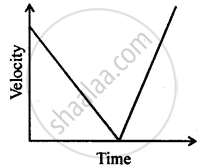Advertisements
Advertisements
प्रश्न
A train travelling at 20 m s-1 accelerates at 0.5 m s-2 for 30 s. How far will it travel in this time ?
उत्तर
We have to find the distance travelled by the train. We have the following information given,
So, initial velocity, (u) = 20 m/s
Acceleration, (a) = 0.5 m/s2
Time taken, (t) = 30 s
We can calculate the distance travelled by using the 2nd equation of motion,
`s = ut + 1/2at^2`
Put the values in above equation to find the distance travelled by the train,
`(s) = 20(30) + 1/2(0.5)(30)^2`
= (600 + 225) m
= 825 m
APPEARS IN
संबंधित प्रश्न
Give one example of a situation in which a body has a certain average speed but its average velocity is zero.
A motorcycle moving with a speed of 5 m/s is subjected to an acceleration of 0.2 m/s2. Calculate the speed of the motorcycle after 10 seconds, and the distance travelled in this time.
When a car driver travelling at a speed of 10 m/s applies brakes and brings the car to rest in 20 s, then retardation will be :
A bus increases its speed from 36 km/h to 72 km/h in 10 seconds. Its acceleration is :
A bicycle initially moving with a velocity 5.0 m s-1 accelerates for 5 s at a rate of 2 m s-2. What will be its final velocity?
Derive the following equations for uniformly accelerated motion:
(i) v = u + at
(ii) `"S = ut" + 1/2 "at"^2`
(iii) v2 = u2 + 2aS
where the symbols have their usual meanings.
When is the negative acceleration?
Multiple choice Question. Select the correct option.
The speed of a car reduces from 15 m/s to 5 m/s over a displacement of 10 m. The uniform acceleration of the car is :
Can you suggest a real-life example about the motion of a body from the following velocity – time graph?

A body is thrown vertically upward with velocity u, the greatest height h to which it will rise is,
